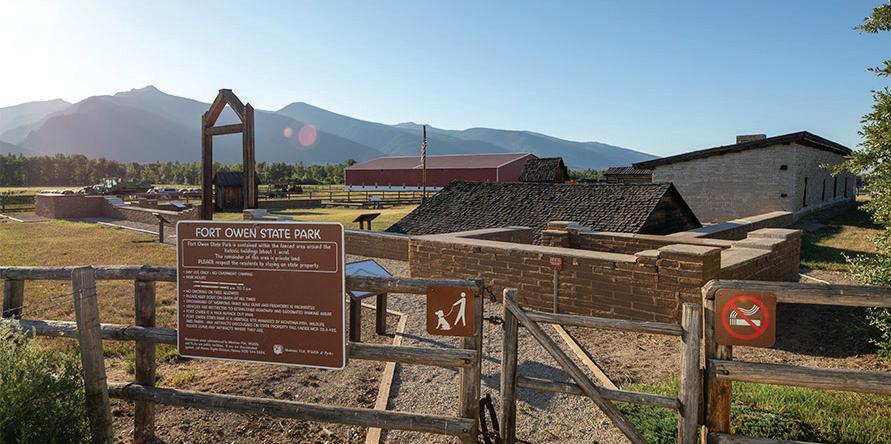
4 minute read
Bitterroot National Forest
BITTERROOT FOREST
Photo by Perry Backus
Advertisement
HISTORY OF THE BITTERROOT NATIONAL FOREST
The Bitterroot National Forest has been occupied by humans for 8,000 years or longer, and is the traditional homeland of the Bitterroot Salish Indians. It was also frequented by other tribes including the Kootenai, Pend d’Oreille, Shoshone and Nez Perce. These hunters and gatherers harvested plants and animals throughout the year. The Lewis and Clark Expedition of 1805 was the first recorded contact of Euro-Americans here. After crossing the rugged divide near what is now Lost Trail Pass, Lewis and Clark descended into Ross’ Hole (located near Sula, MT) and encountered an encampment of Bitterroot Salish preparing to travel to bison hunting areas east of the Continental Divide. Seventy-two years later when the Nez Perce fled their homeland in Idaho they retraced Lewis and Clark’s route into the Bitterroot. After passing peacefully through the valley, they were confronted by a regiment of soldiers and the Battle of the Big Hole ensued. A segment of the Nez Perce National Historic Trail, known also as the Nee-Me-Poo, can be hiked on the Sula Ranger District. Euro-American occupation of the Bitterroot Valley accelerated in the 1860s with the discovery of gold, first in Idaho and then in Montana. The valley’s relatively mild climate and abundant water supplies were well-suited to agriculture, making it the “bread basket” for mining camps throughout southwestern Montana. Although relatively little mining activity occurred in the Bitterroot, the Overwhich-Hughes Creek Mining District in the upper West Fork of the Bitterroot was a bustling gold district in the 1890s and early 1900s. Gold was also mined in the hills east of Stevensville during this time, and the Curlew mine near Victor produced silver, lead, zinc and gold ore well into the 20th century. The lumber industry began its development in the 1880s. Much of the timber harvested was cut from public land until 1897, when the Bitter Root Forest Reserve was created. This made it part of a national effort to help preserve the forests in the western United States from further devastation. In 1907, the newly created U.S. Forest Service converted these forest reserves into National Forests, marking the beginning of National Forest Conservation and management policy. The Bitter Root Forest Reserve and portions of neighboring reserves became today’s Bitterroot National Forest.
The 1.6 million acre Bitterroot National Forest, in west central Montana and east central Idaho, is part of the Northern Rocky Mountains. National Forest land begins above the foothills of the Bitterroot River Valley in two mountain ranges--the Bitterroot
ABOUT OUR NATIONAL FOREST
Mountains on the west and the Sapphire Mountains on the east side of the valley. The nearest urban area is Missoula, Montana, located 40 miles north of Hamilton, Montana. Elevation ranges from 3,200 feet at the north end of the Bitterroot Valley to Trapper Peak at 10,157 feet in the mountains on the south. In the Idaho portion of the Forest, elevations drop to about 2,600 feet along the Selway River and 2,200 feet on the Salmon River. In response to the changing needs of society, land managers on the Bitterroot National Forest use the principles of multiple use and ecosystem management to develop their objectives. Based on the sound principles of biological diversity and landscape management, the forest supports productive, healthy diverse ecosystems while providing the goods, services, values and opportunities that people desire. These include recreation, wildlife, fisheries, water, cultural resources, as well as timber, minerals, and grazing. In the drier valley floor and lower foothills there is an arid-lands mix of grasslands, shrublands, and ponderosa pine that borders cottonwood forest along rivers and streams. On grassland ecosystems, wildlife and domestic livestock share forage. These rangelands provide benefits like wildlife habitats and recreation. Mid-elevations receive more moisture and are habitat for stands of Douglas fir, lodgepole pine and western larch. Higher elevations produce Engelmann spruce, subalpine fir, subalpine larch and whitebark pine. Vegetative management of the forest provides a sustained yield of forest products including saw timber, post, poles, and firewood, while providing improved wildlife habitat, forest health and high quality watersheds. Alpine lakes, mountain reservoirs, fast running streams and the meandering Bitterroot River offer anglers the opportunity to fish for brook, rainbow, and brown trout. Be sure to consult the current Montana or Idaho fishing regulations for details. The Bitterroot Forest is home to many species of wildlife, from mule deer, whitetail deer, elk, bighorn sheep, mountain goats, black bear, mountain lions, and moose, to many varieties of smaller animals and birds. Wildlife viewing areas offer you the opportunity to view them in their natural habitat. Recreation opportunities abound. Try some popular activities like camping at eighteen developed campgrounds, hiking or riding on more than 1,600 miles of trails, fishing, hunting, rafting, boating, kayaking, mountain biking, rock climbing, horseback riding, wildlife watching; downhill and crosscounty skiing; snowboarding and snowmobiling to name a few. Forty-seven percent of the Bitterroot National Forest (743,000 acres) is comprised of portions of the Anaconda-Pintler, Selway-Bitterroot, and/or Frank Church-River of No Return Wilderness.
Trusted & Local


A Retirement Community th A Retirement Community That Offers:at o ers:Our community of full-service •Independent Living • At Home Services •Assisted Living •Memory Care brokers is backed by a trusted brand and top-notch training. You can count on their expertise Affordable housing for all incomes every step of the way.
Call for a tour TODAY!
(406) 363-2800 • 501 N. 10th St, Hamilton(406) 363-2800 501 North 10th St. Hamilton, MT 59840 sapphirelutheran.org sapphirelutheran.org Windermere Real Estate l 1920 N 1st Street Ste A Hamilton, MT 59840 (406) 363-3222











